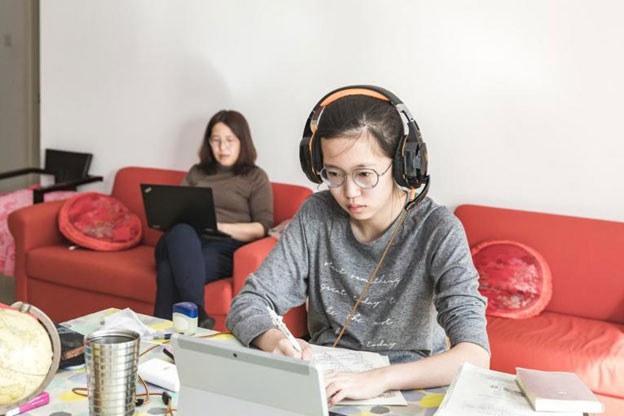In Beijing, China, 11th grader Xiaoyu studies at home while her mother also works remotely. (Credit: UNICEF/UNI304636/Ma)

Simone Galimberti
Inter Press Service
Children all over the world are having tough times while coping with the consequences of the pandemic but the circumstances affecting them in the Philippines are even more daunting.
The learning crisis that has been affecting millions of vulnerable children deprived of their education throughout the lockdown as schools remain shut, is probably its most visible example whose resolution will require strategic vision, long term commitment and a holistic dimension all together.
The situation remains even more worrisome due to the draconian regulations surrounding the imposition of strict lockdown measures for minors within Metro Manila Council, where children have been prohibited from going out since March.
The controversial decision did not come out of the blue but instead builds on rules being enforced by the Inter-Agency Task Force for the Management of Emerging Infectious Diseases, whose decisions have been defined as opaque by the Economist.
Throughout the lockdown the Task Force took a hardline position forcing millions of children to strictly abide to home stay regulations, basically indicting them to something resembling reclusion and segregation.
The measure has been widely condemned across the spectrum as disproportionate and too much restricting of the rights of the children.
“These measures should consider the highest level of acceptability and feasibility, proven effectiveness and should minimize the negative consequences on health and well-being of all members of society” according to an official statement by UNICEF Philippines released on March 19.
Certainly, there is not an easy way out to ensure that children from most vulnerable communities can have their rights fully re-enforced as the pandemic has exposed long simmering fractures in the system that have systematically penalized poor kids.
Ideally, a common solution to the problem should be found within ASEAN but till then, the onus goes on better policy making that should be open to collaborations and partnerships.
Closing the digital divide would allow better conditions for disadvantaged kids not to be left behind in any future scenario where another pandemic might strike.
It means huge investment from the Government but also from the telecom sector together with resources being allocated by external development partners like the Asian Development Bank, the World Bank, the European Union and others.
Reaching out to the most vulnerable segments of the citizenry with appropriate technology would create the market incentives for a massive rollout of fast connectivity that, if properly subsidized, would create incentives to telecoms to invest in the most deprived areas of the country, including urban pockets with high levels of vulnerability.
At the same time, an inclusive digital blueprint, a goal also being pursued collectively at ASEAN level, will not make up for other types of investments the education sector is desperately in need for.
The Philippines like many low-income nations must prioritize investments in public education from better teaching to better equipped infrastructures to a wider social protection system with financial measures directly targeting the most vulnerable children and their families.
The challenge is to strike a balance between short terms needs and longer terms benefits, using the current crisis instrumentally, laying the foundations for more equitable child focused public services, assuring a national framework but also a locally effective governance systems that prioritize children’s needs.
Obviously, education and health are the key cornerstones of such a new child centered approach to government.
UNICEF has been trying to provide a global template on how to effectively ensure that minors are not paying the highest price while enduring the perverse effects of this pandemic.
The A Six Point Plan to Protect Our Children is a blueprint on how to mitigate the impacts of the pandemic on children, covering areas from inclusive education to equitable health service to better child protection measures and stronger actions to access clean water, sanitation and hygiene without losing the focus on climate change.
“For education, we are working with DepEd and DOH to establish a system for up-to-date, real-time risk assessment of critical populations to map out risk levels and service gaps across DepEd regions/schools divisions and districts/schools to be used for scenario-building, planning and budgeting for safe school reopening” according to UNICEF Philippines Representative Oyunsaikhan Dendevnorov.
Re-opening schools remain a priority for the Philippines and more could be done to come up with joint responses to the learning crisis from the region, considering that the issues faced by children in the Philippines are shared with other low-income nations within the ASEAN.
Unfortunately, the latest meeting of the ASEAN Education Ministers, coordinated by the Philippines, happened on the 20th of November last year and the next one is only supposed to be scheduled for 2022.
During that meeting the Philippines championed the idea of “Transforming Education the ASEAN Way: Forging Partnerships in the Age of Global Disruptions” but this looks more like a catchy slogan than a well thought plan.
The recently held meeting of the ASEAN Socio-Cultural Community (SOC-COM), under which children related issues fall, also did not provide any transformational solution and was the usual long declaration short in practical actions.
With regional cooperation unable to provide the required impetus to improve the immediate needs of children in the Philippines, then it is essential to come up with concrete measures that can help localize and adapt the UNICEF’s six-point action.
First of all, the strictest aspects of this lockdown now enforced in the Capital region must urgently be addressed as its consequences will have an impact too severe on children especially on their emotional wellbeing.
As the mayors of Metro Manila have started deliberating the so called “flexible” modified enhanced community quarantine (MECQ), such new arrangements must ensure that right to education of the most disadvantaged children.
With the current school year approaching its end BY mid-July, perhaps it is time for some experimentation focused on ensuring a smooth start of the new academic year slated for the 23rd of August.
Working on the digital divide and fixing the problems faced by the Department of Education while imparting distance learning should be a priority.
On this front there are certainly many lessons learned, as admitted by Education Undersecretary Alain Pascua.
Improving distance learning from the quality perspective and working on the equity side with investment in accessible technologies and digital infrastructures should not come at the expenses of immediate action for a partial return to face-to-face education.
In this regard, pilot experiments should be held to allow kids to be back in the classroom with different modalities being tested, including blended learning modalities with shifts and half classmates attending physically while others digitally wherever possible.
For example, as soon as the situation will allow, those children staying at home could gather in smaller groups within their neighborhoods, an effort that could be supported by a national call for action in which graduate students will step in as support teachers.
There is also a lot of potential in the Department of Education’s Alternative Learning System (ALS) that is centered around the concept of flexibility that is so paramount for vulnerable children who have dropped out from school.
Further scaling the research work carried out in this area by De La Salle University with the support of the World Bank could be a smart investment to be undertaken. Ensuring better targeted approaches to fight the increasing levels of child poverty is also essential.
“Support to data collection to provide timely information on the situation of children and families, and advocating increased spending for the most vulnerable children and coverage of the Pantawid Pamilyang Pilipino Program (4Ps) to include all children living in poverty”, are essential and tasks Unicef Philipines is committed to contribute as Dendevnorov further explains.
Getting this right is a complex process but the Government of the Philippines has to step up its commitments to ensure the rights of children are fully upheld, balancing short term needs with longer terms planning.
On the latter, there is also an opportunity to re-think the entire education system, not only making it pandemic proof but also transformative and quality based as well, ensuring a learning experience that will positively shape children’ up brining.
This is the proposal from the Philippine Chamber of Commerce and Industry that is putting together a task force to come up with a list of recommendations that would address the fault lines of the educational system being exposed by the pandemic.
This task force will start operating amid calls for a new official education commission to be designed on broader reforms, possibly charting what has been defined as a “realistic road map” for change, leveraging new collaborations between the government and the private sector and civil society that could bring positive outcomes for the future of the learning in the country. ‘
Will any discussions on educational policy reform putting at the center of the deliberations the interests of the most vulnerable children, not only from a quality learning perspective but also from a child protection dimension?
While better exchange of information and the pursuit of a common approach within ASEAN would be desirable in winning the challenge of inclusive learning in a post pandemic world, for now it is up to the Government of the Philippines to work in partnership with the civil society, the private sector and international organizations for holistic and child centered solutions.
It is a gigantic challenge ahead, charting out doable and practical actions in the immediate while drastically reform the way education is imparted in the country.
Only a long-term vision followed by steadfast political commitment and a genuine desire to be open to collaboratives, will offer the right blueprint for a renewed focus on children’s wellbeing in the country.
The writer is Co-Founder, ENGAGE, Inclusive Change Through Volunteering and writes on social inclusion, volunteerism, youth development, regional integration and the SDGs in the context of Asia Pacific.





